Mexico: Temples and Monarchs
Jan 2020 |

random trip report |
[Click images for large version and again for full resolution]
Each year millions of monarch butterflies migrate from the northern U.S. and Canada to forests in Mexico's Sierra Madres mountains. My friend A. suggests that we visit these colonies, and check out Ciudad Mexico (CDMX) on the way.
Tue 1/7
A. buys bran muffins in SFO; more on these later.
We arrive in CDMX ~8 PM and take a cab to the Hotel Casona. On leaving the airport we're immediately in the city, which is sprawling, mostly old, gritty but clean.
The Hotel Casona, on Calle Durango, is old and full of character; it's decorated with all sorts of musical objects. The staff is extremely friendly and helpful.
We search for a restaurant. The neighborhood (Roma Norte) is surprisingly dead; not much open, few people on the street. We end up at Cervezeria de Barrio, which has awful music and food, and no decent beers, but is otherwise OK.
We walk a bit along Durango. A parked van disgorges a surprising number of Mariachis, who enter an apartment building and play.
The bed at the Casona is firm verging on hard; I don't sleep.
Wed 1/8
We walk to the Chapultec park, past a Mussolini-ish monument. We check out the Museo de Arte Moderna, which is not impressive although I do like the domed translucent ceilings resembling the spotted surface of the sun.
We move on to the Museo de Anthropologia, which is absolutely awesome. It's a huge, modern complex with 8 large halls devoted to various periods of Mexican history from prehistory up to the Spanish conquest. I find it very thought-provoking, e.g. how social units scale from dozens to millions, and the role of religion in this process.

The Aztecs played baseball!
We walk back through the park, which is full of vendors all selling the same stuff. We stop for street tacos, which are excellent and cheap.
After a siesta, we take a cab to the old city, or Zona Historica, centered at the Plaza Zocalo, which is surrounded by a giant cathedral and various goverment buildings. We walk through the nearby pedestrian mall. Small children play guitars and accordions, terribly, for money. Adults in uniforms play a sort of hurdy-gurdy with panpipes, which is loud and cacophonous.
There are lots of clothing stores; everything is "En Rebaja". I see a wool jacket in a window but resist A.'s urging to try it on.
We eventually get hungry and look for a restaurant on Yelp. We find a promising place, Mata, but have a hard time actually finding it. Turns out it's on the 2nd floor, and there's no sign. But it's very good. Seated by a 2nd-floor balcony window, we both get ceviche-type dishes and IPAs, and a unique roasted plantain dessert.
There seems to be only one jazz club in CDMX: Zinco. It's nearby, and we go there when it opens at 9. Workers deliver many crates of beer. It's clear the music isn't going to start for a while, so we leave. There are no cabs on the street; we get one by asking at the Zocalo Central hotel.
Thu 1/9
We leave at 9 AM for a guided tour of the pyramids of Teotihuacan. The van also picks up a couple from Uruguay (a civil engineer roadmaker and GF), and a group from Costa Rica (young couple, geology professor, 2 older women).
The guide, Miguel ('aventurasancestrales' on Facebook) is very energetic, charismatic, and theatrical. His head is packed with information: the etymology of Aztec words, the names of archaeologists, and so on. He subscribes to many theories involving aliens, Atlantis, and pseudo-astronomy. He's a fan of prog rock, and his play list is interesting. He's English is good. Hire him if you're in CDMX.
We leave the city and drive past mountains carpeted with garish human development.
The trip turns out to involve an element of commerce. At the first tourist trap, an elderly man, Jose, with a single gold tooth and sleek gray hair, demos the many uses of the agave plant. The store has rip-off prices on jewelry, booze, jewelry, and stone objects, including tasteless jaguar heads and Aztec masks. I buys a bottle of agave liquor and a smooth obsidian stone at prices, it turns out, many times market value. A. is taken by the jewelry, and ends up getting a very nice fire opal necklace.
The pyramid area is huge. It's partly reconstructed; the new parts are indicated by small rocks in the mortar. Miguel demonstrates echoes, claiming they can't be explained by acoustic science.
Vendors hawk instruments that can produce a jaguar-roar sound.
We climb Moon pyramid, then Sun Pyramid. There are no guards around, but I resist the urge to leave the steps and go cross-country. A. is winded and gets sore legs but makes it to top.
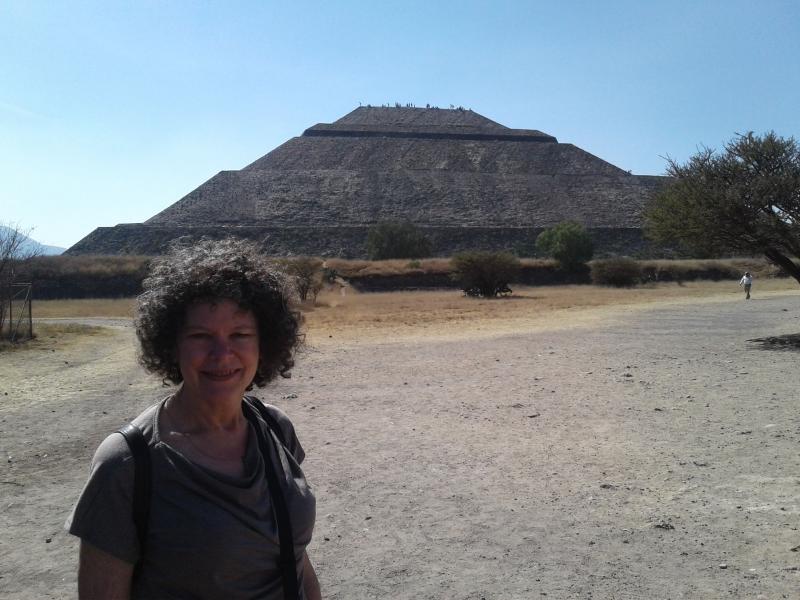
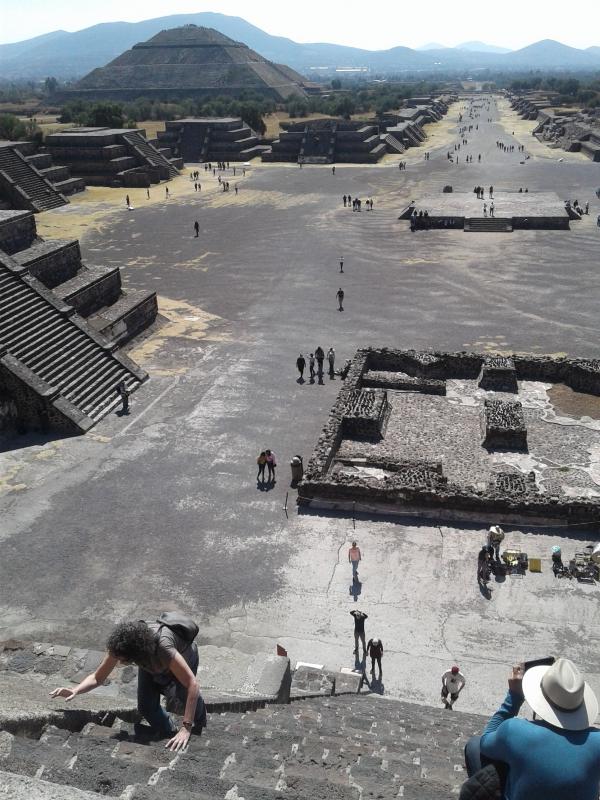
On return to parking lot, A. craves an ice-cold diet Coke, and eventually finds a guy selling them out of his trunk. She also buys a straw hat.
Next stop: the inevitable tourist buffet. There's a loud Mariachi band with an excellent singer but fair-to-poor violin and trumpet. A. gets queso fundido w/ mushroom, which is good but takes a while. I nibble on bran muffin.
Pseudo-Aztec dancers perform with giant feather headdresses and drums.
Final stop: the Basilica de la Virgen de Guadalupe. At a tourist store, Miguel tells the cock-and-bull story of the miracle: the Virgin tells a peasant to ask the Bishop to build a cathedral, he's turned down a few times, the Virgin gives the peasant roses, which turn into 3x8' oil painting of her with stars and rays. There's something about reflections in the eyes. Whatever. Read the Wikipedia article if you're interested.
We briefly visit the old cathedral, built on old lake short and partly sinking. We proceed to the modern 10,000-seat cathedral housing the painting. To see the painting, you go on motorized walkways underneath it, and you get 10 seconds to look.
We have dinner at Limosneros, a fancy place in the old town. They don't have our reservation - turns out A. made it for tomorrow - oops! It has nice, modern ambience. We have cocktails and a tomato appetizer that is not quite OK. A. gets sweetbreads, I get steak - good. The creme brulee is very good.
Fri 1/10
We take the subway to Zocalo. It's 5 pesos and very convenient. A. has a contact lens crisis.
Outside the Plaza Mayor there are more feathered-headdress dancers.

We run into the Uruguayan couple from yesterday. We tour the Plaza Mayor excavation and museum. It conveys the greatness of those civilizations, and the horrible and extreme lengths to which the Spaniards went to destroy them. They destroyed temples and built the National Cathedral where they had been.
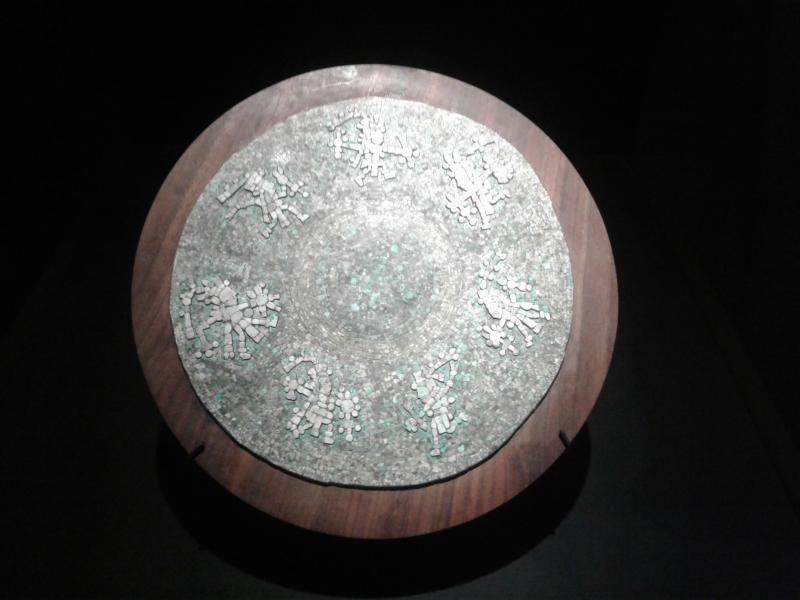
This is made of 5,000 tiny pieces of turquoise
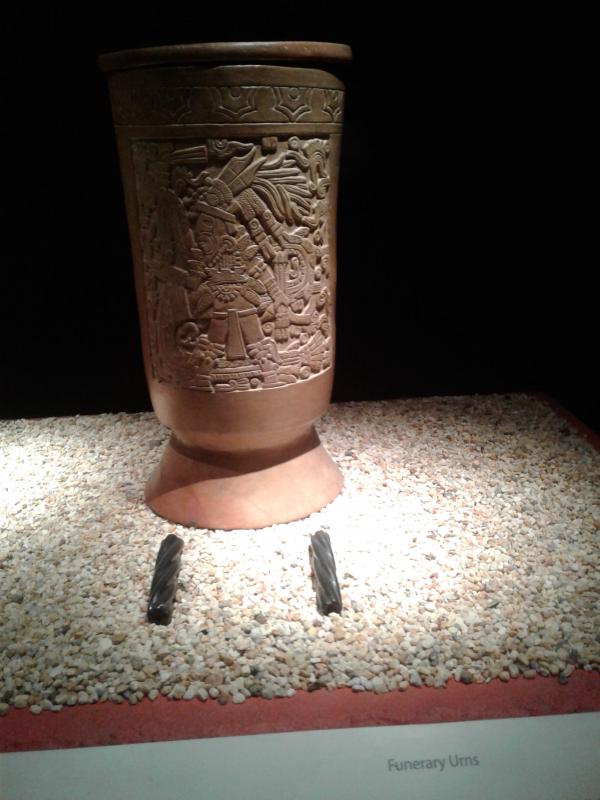
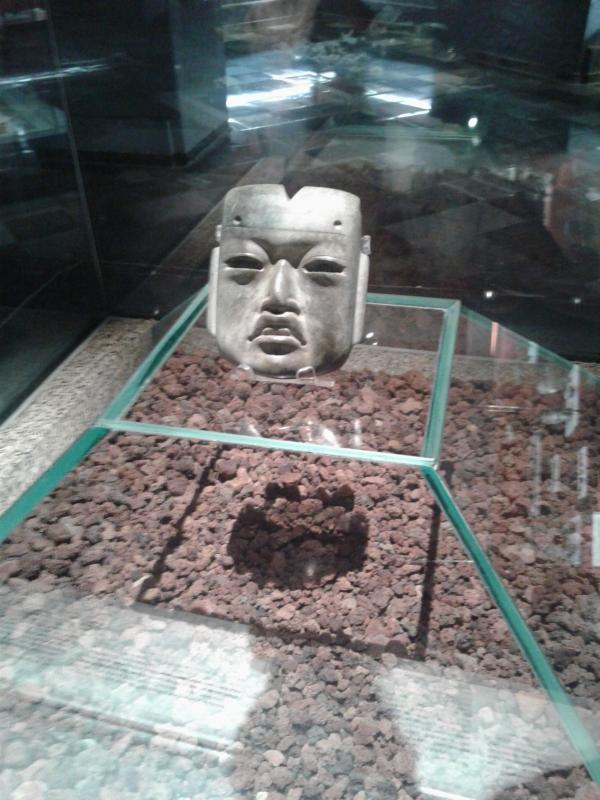
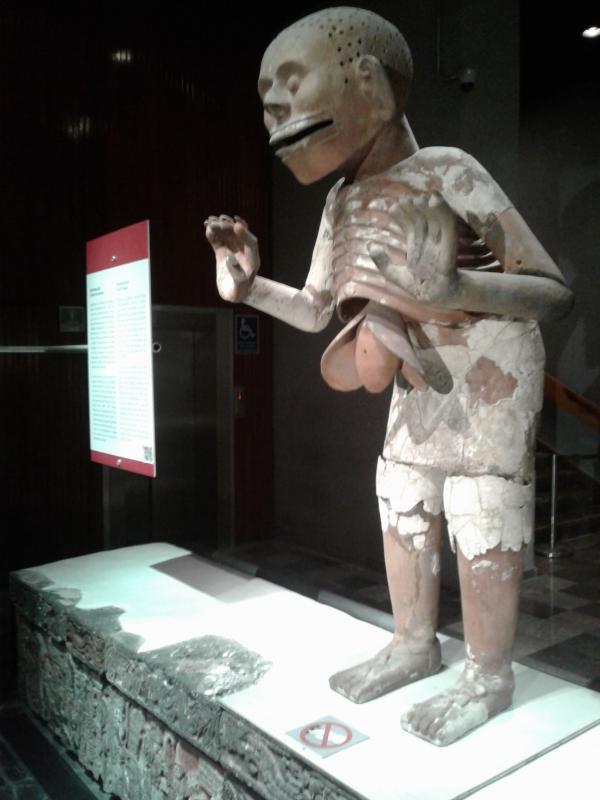
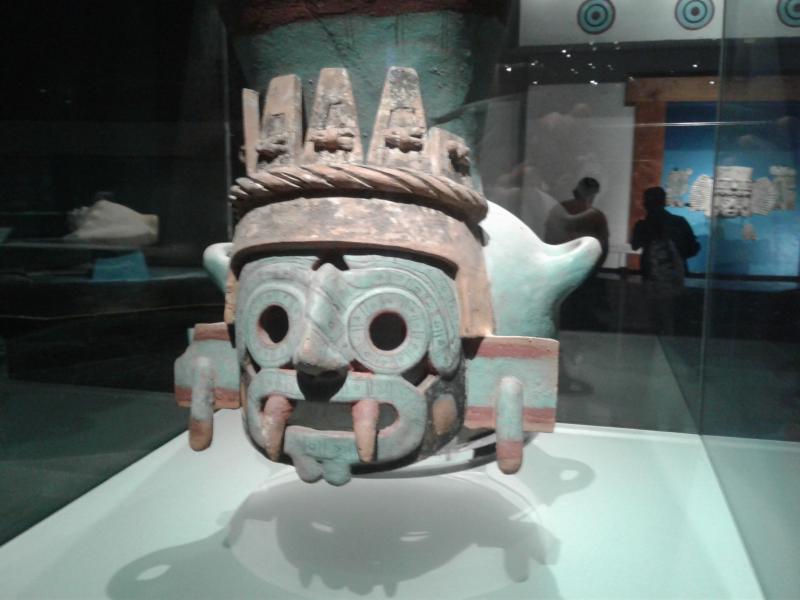

Excavation at Plaza Mayor
We visit the Palacio Nacional and see a number of huge Diego Rivera murals.
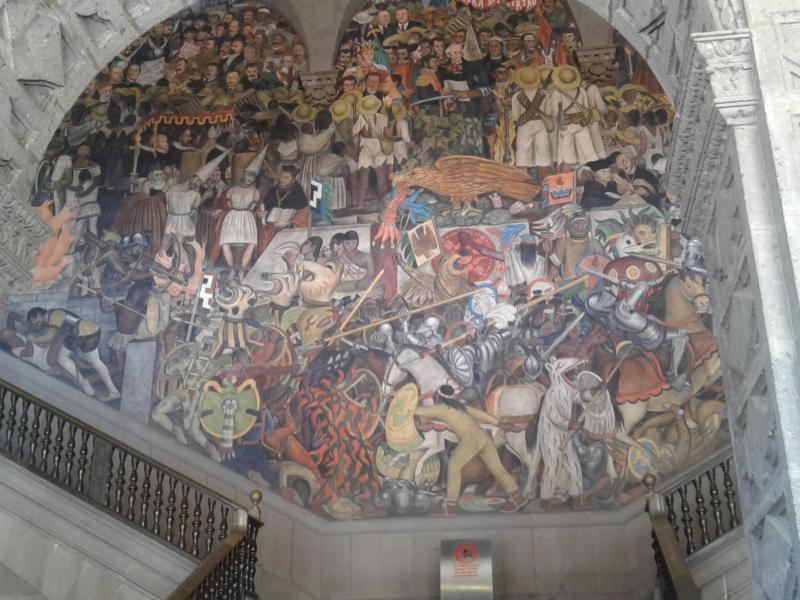
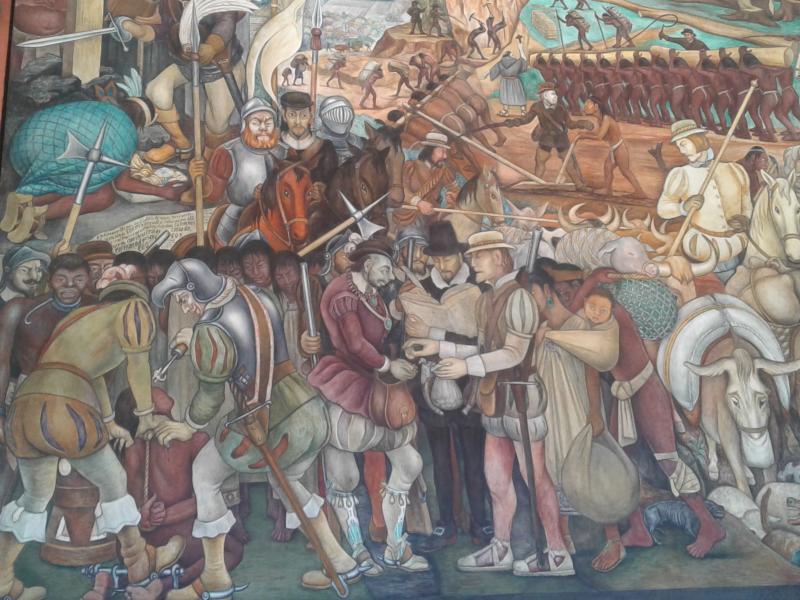
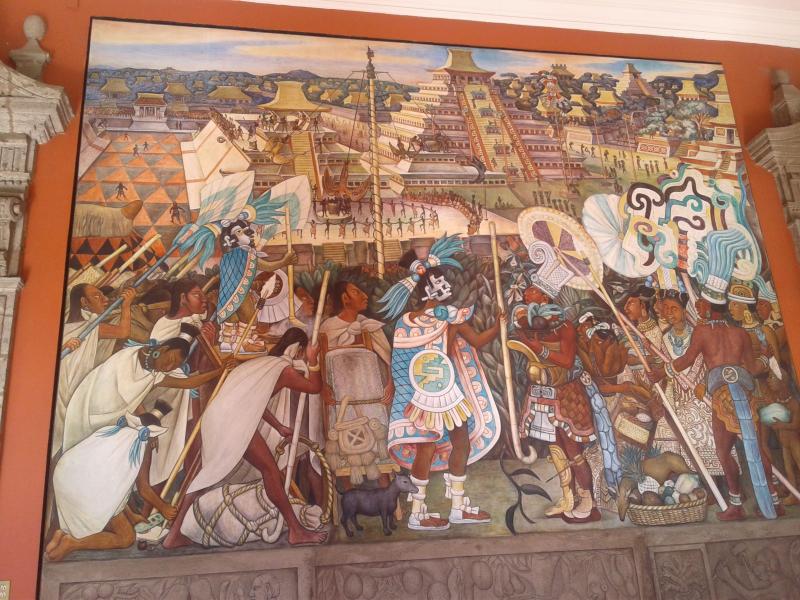
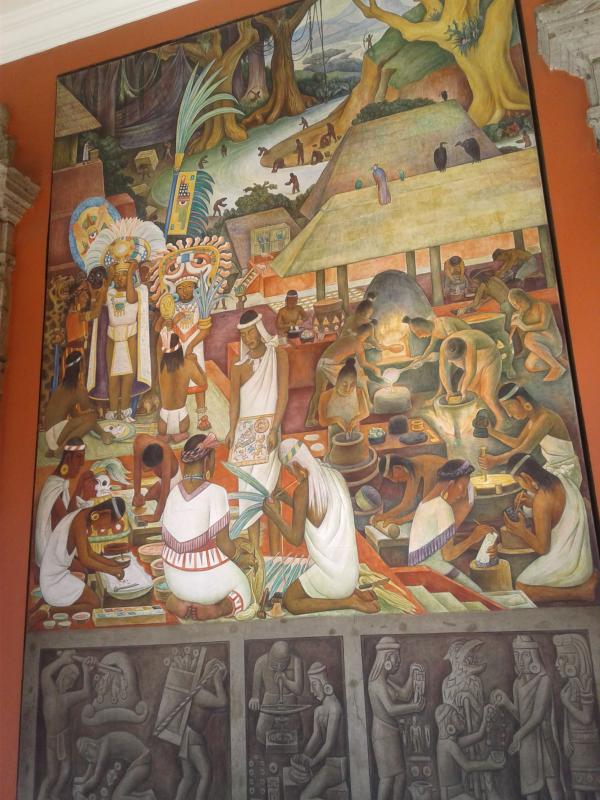


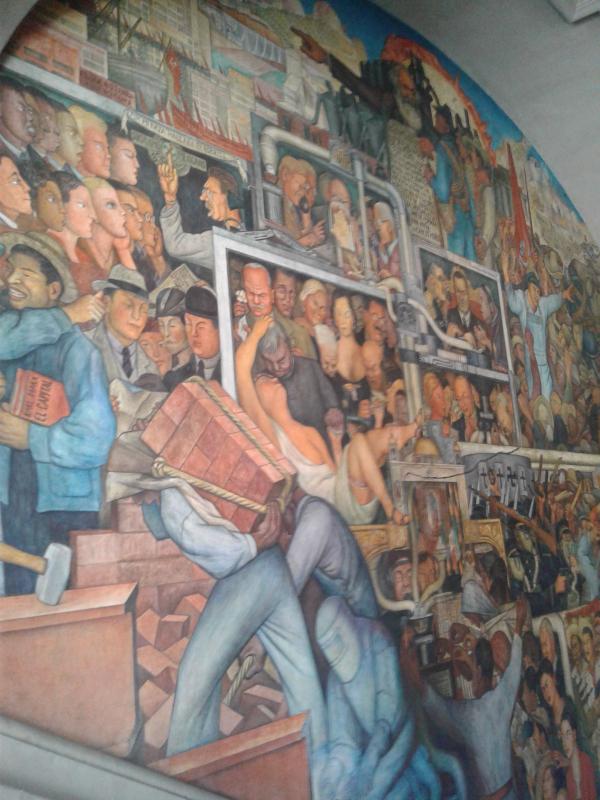
We walk toward the Mercado Ciudadela. We look in the huge and gorgeous Beaux-Artes Palacio de Correos, i.e. the main post office.
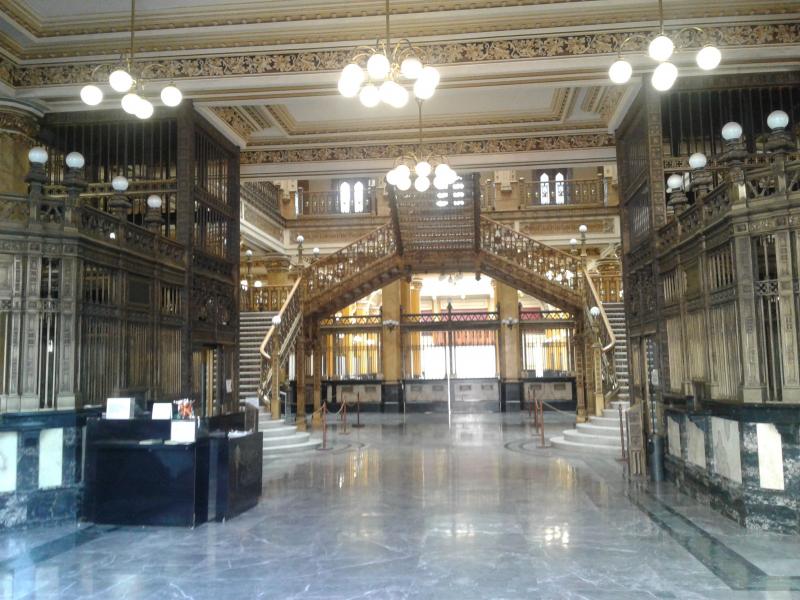
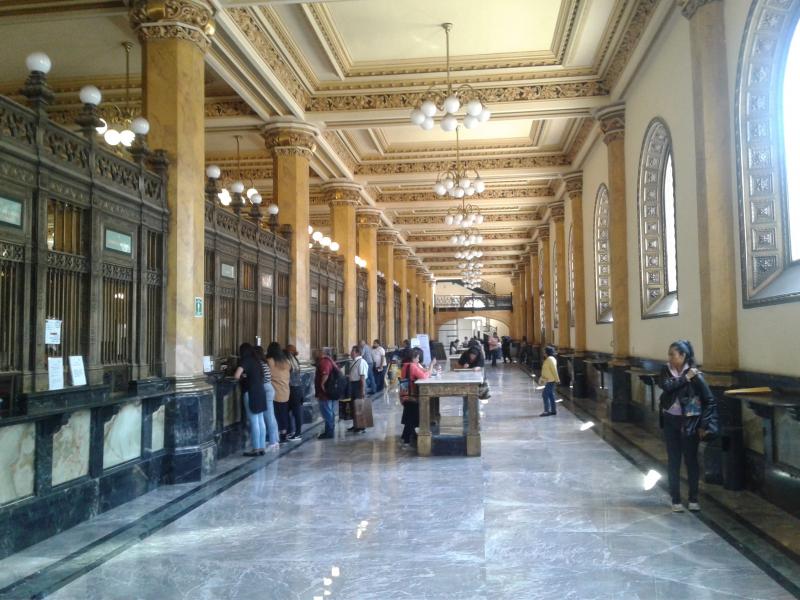
The market is very hard to find. Although it covers a few square blocks, its entrance is a small unmarked opening in a wall.
A. buys shirts for herself, and painted cats for the kids. We eat at an extremely bad and slow restaurant. The Costa Ricans from yesterday stop by and chat. I finish the bran muffin, which seems to have improved with age.
We rest a bit and do some web research on live music in CDMX. There's not as much as one would hope. No classical as far as I can tell, only Zinco for jazz. We find a place, Mama Rumba, that has salsa music, so we head there.
First, to keep things simple, we go to La Negra taqueria for dinner, which is only OK. Then we walk toward the club, and pass a dozen restaurants that look extremely groovy and better than the taqueria. We get disoriented and walk in circles a lot, but see some interesting areas. I am taken with an ad showing a smug young man in jacket with subtle jaguar print.
Mama Rumba has a $120 cover charge, and they detain A's water bottle. Once inside we learn that music starts at 11 a punto. Too long. We get a drink, sit at one of many reserved booths, and leave.
It's true that we made entirely wrong decisions this evening, but it was fun nonetheless, and we'll know where to go next time.
Back in the room, it dawns on me that I can't take the agave liquor home without checking my bag. So I open it and have a slug.
Sat 1/11
Ann, poor thing, has come down with a cold and has a sore throat. I have huevos Benedictinos for breakfast. We check out, take the subway to the Observatorio station, cross the street to an airport-like bus station, and get on the bus for Zitacuaro. The bus has TV screens; we see "Bohemian Rhapsody" in Spanish. The AC works intermittently. It's a 2-hour ride through semi-arid rolling pine forests to the town of Zitacuaro, which is at the base of some forested mountains (the Sierra Madre). it's a 30 minute cab ride up to Macheros, a miniscule village at about 8,500'.
We arrive at J.M.'s Butterfly B&B around 3. It consists of several fairly modern buildings, and is run by Joel (native) and Ellen (American). It's groovy - we're told the yoga class is at 4. The room is nice. One must put toilet paper in the waste basket rather than the toilet.
I enquire about hiking trails, and am directed to a medium-size hill nearby. I run into the yoga instructor - Caitlin - on the trail, and we chat briefly. I continue to the top of the hill; it's a beautiful hike. Later Caitlin tells me there are some ruins a bit farther on the trail, that were looted 30 years ago.
I return for the yoga class, which is mellow and new-agey. There are 5 older women in the class, talking excitedly about the butterfly tour they just finished.
People congregate on the roof for an informal happy hour. I drink some of my agave liquor. I chat with a British woman, Elise White, an equestrienne, who just finished a 4-day horseback pilgrimage and wants to create a horseback tourism business. There's also a young man from Montana, Will, who is in graduate school studying transnational ecology, e.g. migrations of various sorts. He's in Mexico to do research at the archives in CDMX. A young man is there with his 6-year-old son Heron, who's blond and high-energy. Peggy and David are a 70-ish couple (together only for 3 years) from Alabama. Jimi-Jimi is an aging hippy from Minneapolis who gardens and teaches dance; he knows people everywhere and travels a lot. There's a family of 4 from Australia who don't interact with anyone.
We have dinner at the adjoining restaurant, which is run by a local family and is also groovy. We sit with some different older American women, some of whom have moved to Mexico. One of them - Fay - is in the spiritual relationship counseling business and is trying to sell her fancy flute.
A. and I both have foil-wrapped trout, which is big, good, and absurdly cheap (150 pesos, or about $7).
One of the women, Juanita, is turning 75, and the restaurant makes her an enormous tres leches-type cake, which we cut and distribute to everyone in the restaurant. Mattias, a very cute 2-year-old son in the family, sits with us for a while and demolishes a piece of cake. I have a spoon swordfight with him.
Sun 1/12
The bed is super comfortable, but I sleep little because of A.'s congestion-related snoring.
We have breakfast at the restaurant, and prepare for our visit to the Cerro Pelon butterfly sanctuary. This is one of the destinations of a monarch butterfly migration starting in the northern U.S. and Canada. They fly south in one fell swoop, and spend a few months here. On the way north they stop and reproduce 3 or 4 times - i.e. the ones who finally reach Canada are not the same ones who started. No one knows how they manage to go exactly the same way each year.
Our group of 12 or so sets out at 10 AM, on horseback. Each horse is led by a local. It's about 2 miles up a somewhat dusty trail. The forest is beautiful - sort of jungle-like, with hanging vines, but with lots of pine trees. Some of the trees are tapped for their sap, which is used to make resin and medicinals.
At the top, about 10,000', there's a big meadow with millions of butterflies, flying by in a constant stream. It's psychedelic, and reminds me a bit of Hitchcock's The Birds.
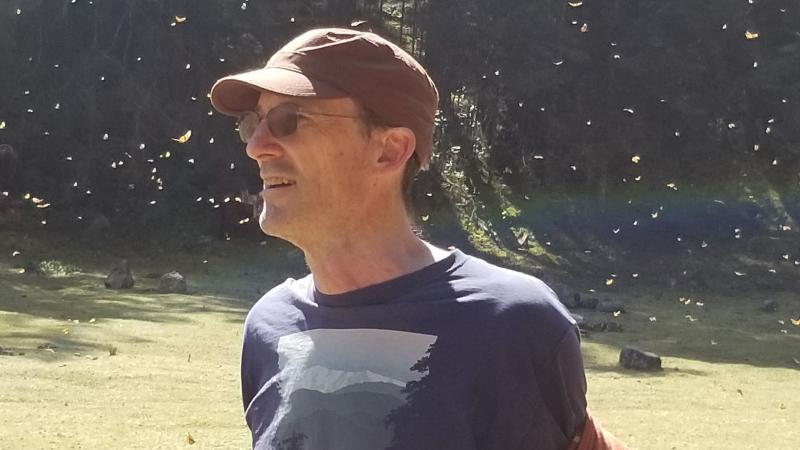
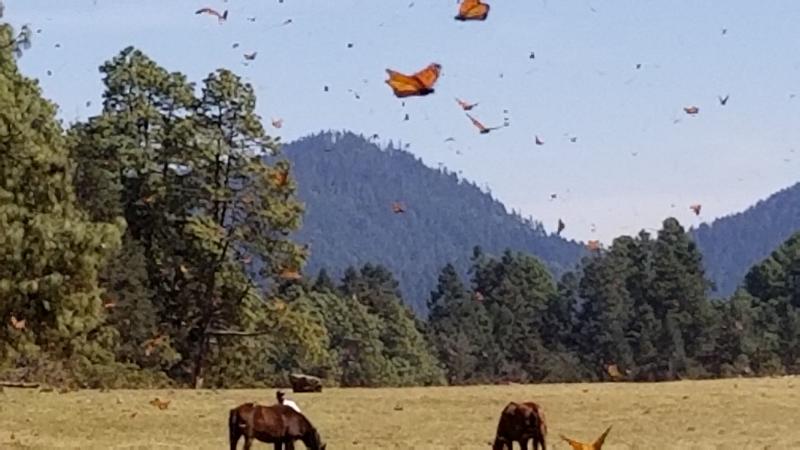
We dismount and hang out in the meadow for a while. Then we walk uphill for a hundred yards, to the colony itself: a bunch of pine trees covered with butterflies. There's a constant soft whooshing sound: the collected sound of thousands of butterflies flying.
We head back to the meadow and have lunch. We talk briefly with the Australian girl, who says there "varying opinions" about climate change; I infer she's a climate change denier.
Jimi and I walk down; it's a very pleasant hike. My guide, Humberto, follows behind me on horseback. Eventually he gets off, and we walk and chat. I ask him if he does this every day. He says no, only every week or two. There a list of people signed up to do it. He does odd jobs and construction, but there's not much work, and not much money.
Back at the B&B, A. and I sit outside, next to a beautiful blue swimming pool. I don't have trunks, but I strip down to my red undies and go for a dip; I dry off fairly quickly in the dry air.
While A. naps, I do another Yoga class with Caitlin; it's just me and Jimi, and this class is even more soporific. It's a great yoga room except the tile floor is ice-cold.
Another happy hour on the roof. I bring the agave liquor and get some people to try it. I talk with Sally, a delightful 70-ish woman from Boston; she spent the day taking a cooking class at the restaurant, and making green chicken mole. Elise tells a story about staying in a luxurious but decaying hacienda with a 92-year-old proprietor who breaks out magnums of champagne that turns out to be undrinkable, but they have to drink anyway.
We go to dinner; I order the chicken mole that Sally made, which is perfectly fine. We sit with Peggy and David, and talk about herbal pain relief and other things. Peggy tells me a long story about rescuing her mother from an incompetent hospital that gave her C. Dificil; it took 6 months on antibiotics to get rid of it. A. and David talk politics, and are in fundamental agreement although David considers himself a Republican. Peggy is into precious rocks, and describes a rock show in Tucson in a building that's so big you can see the curvature of the Earth. I tell her about my obsidian ellipsoid, and she tells me that obsidian absorbs the negative energies emitted by electronics, and that I should keep it near my computer.
Mon 1/13
At breakfast we talk with Sally and Linda. Apparently the cumbia last night went on for an hour, the restaurant familia joined in, and a good time was had by all. We say goodbye to various people, and hello to a couple from Nebraska who have just arrived and want beta on CDMX.
I leave my half-bottle of agave liquor in the common room; hopefully someone will finish it. A. leaves her straw hat.
As a result of an email misunderstanding between A. and Caitlin, our car to the airport arrives at 9 instead of 11. We hurredly pack and leave a bit after 10.
A. and I play two games of Botticelli: Chopin and Flaubert. But she's still sick-ish and her voice gives out. We give the driver a big tip (the rest of our money) to make up for him waiting an hour.
At the airport security, the guy wants to confiscate my obsidian rock. I bitch and gesticulate, other guards are called over, they examine the rock and feel its heft, and finally let me keep it. I suppose they viewed it as a potential weapon.
Observations on Mexico
Mexicans are extremely friendly and helpful, compared with Americans. A. and I were looking lost in a subway station. A man came up, asked if he could help, and steered us in the right direction. I thanked him and smiled; he gave me a big smile back, and a pat on the back.
Mexico takes its history, and its archaeology, very seriously (unlike the U.S.).
Mexican society - at least in CDMX - seems at least as progressive as CA. We saw several gay couples holding hands in the street. There are anti-sexual-violence posters in the subway, and anti-corruption posters at the airport. On weekdays, subway stations have women/children-only areas and cars. There's free WiFi in parks and other public places.
There's almost no litter on streets or along highways. There are almost no homeless people (possibly because the government hires them to clean the streets). There's an awareness of recycling. Miguel says that single-use plastic bags will be banned in CDMX later this year. I saw no feral animals.
Certain stretches of highway have a major surplus of signs, e.g.:
- Don't drive tired
- Obey the speed limit
- Don't cross the solid line to pass
- Obey the signs
- Do not damage the signs
A. suggests adding "Eat your vegetables".
The story of the monarch butterflies is amazing, but seeing them isn't as life-changing for me as for the others. I guess I like the trees and mountains more.
The B&B clients are adventurous and environmentally aware, so there's a natural affinity among them. Everybody makes friends with everyone else, effortlessly. Peggy and David are Republicans (but not Trumpanzees!) from Alabama. In the U.S. we'd never even meet them; here we become instant friends.